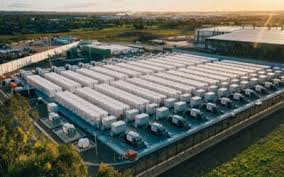
This project marked the start of an ambitious expansion plan for 2025, with accelerated solar and storage development activities. Tesla, a key partner, will contribute its expertise in advanced storage solutions and market access services.
On-site activities commenced in April 2024 with archaeological investigations led by the Communauté Urbaine du Grand Reims, two years after initial discussions with landowners, including the Municipality of Cernay-lès-Reims. Construction is set to begin in January 2025, with grid connection planned for late 2025.
This 240 MW/480 MWh project will perform three essential functions within France’s energy landscape: optimising the use of decarbonised electricity, providing critical capacity during peak demand periods, and enhancing grid stability with near-instantaneous response capabilities. The battery will have the capacity to store approximately 20% of the residential electricity needs of the Marne department, which is home to over half a million residents.
Fully developed and managed by TagEnergy, the Cernay-lès-Reims battery project benefits from significant economies of scale, with a storage capacity nearly five times larger than the country’s current largest operational battery. The project includes a 225 kV connection to the RTE grid and is ideally positioned to capitalize on new short- and medium-term revenue opportunities with the recent opening of the Secondary Reserve (aFRR) market.
“TagEnergy is proud to announce this flagship project in France, just weeks after connecting the first phase of the Southern Hemisphere’s largest wind farm in Australia and the UK’s largest transmission-connected battery”, said Franck Woitiez, CEO of TagEnergy.
“Leveraging an innovative financing structure and deploying storage at scale, the Cernay BESS will contribute significantly to France’s energy sovereignty while enhancing grid stability as renewable energy penetration grows” he added.
Christophe Léonard, Managing Partner for France at TagEnergy, highlighted the project’s alignment with France’s energy transition goals: “The trajectory outlined in France’s Multi-Annual Energy Plan, currently under public consultation, calls for a 2.5-fold increase in wind capacity and a 4-fold increase in solar capacity by 2035. This transformation requires significant development of flexibility solutions. Alongside demand-side flexibility, battery storage is set to become a cornerstone of this transition, and TagEnergy is committed to deploying this technology while accelerating its solar development activities in France in 2025.”
The Cernay-lès-Reims battery project has been made possible through innovative financing, supported by a banking consortium that includes ABN AMRO, NORD/LB, and Caisse d’Epargne CEPAC.
Dan Dorner, Chief Commercial Officer Corporate Banking, commented: “We are happy to have supported this landmark project, which will become the largest battery energy storage system in France upon its completion. This marks ABN AMRO’s first BESS transaction in France, and builds upon our broader BESS and renewable energy track record. At ABN AMRO, we are highly committed to supporting our clients in the decarbonisation of the energy sector in Europe, for which commercial scale battery storage is an essential lever.”
Heiko Ludwig, Global Head of Structured Finance at NORD/LB, stated: “Financing innovative low-carbon energy projects that accelerate Europe’s renewable energy transition is central to our mission. The Cernay battery project is a prime example, and we are delighted to partner with TagEnergy on this flagship initiative that will significantly boost France’s battery storage capacity.”
Jérémy Estrader, Deputy CEO of Caisse d’Epargne CEPAC, emphasised the institution’s commitment to the project: “We are proud to support TagEnergy in this inaugural project in France, which will become the nation’s largest battery storage system upon completion. A historic financier of renewable energy, Caisse d’Epargne CEPAC remains committed to addressing the sector’s new challenges. Electricity storage is a key issue in the energy transition, and we will continue to mobilise our resources to support its development.”